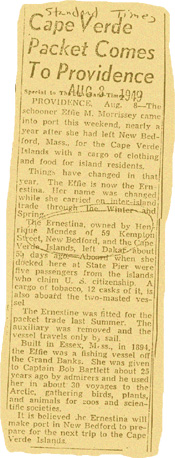|
When the Morrissey first arrived in Cape
Verde, she was an immediate sensation. No schooners had
sailed between the United States and Cape Verde during
World War II. Now Henrique Mendes returned with a
glistening white two masted schooner that was well known
for its Arctic voyages. The entire island of Brava came
down to the harbor at Furna to see this sturdy schooner
flying the American flag. Guitars appeared and
celebrations greeted the vessel in each of the ports she
visited: Furna on Brava, Sao Filippe on Fogo, Praia, and
Mindelo.  Upon reaching the
islands, Henrique registered the schooner in Cape Verde,
changed her name to Ernestina after his own
daughter and used her in inter-island trade. Upon reaching the
islands, Henrique registered the schooner in Cape Verde,
changed her name to Ernestina after his own
daughter and used her in inter-island trade.
In spring 1949, Mendes organized a
return trip to the United States and found five
passengers anxious to go. John Baptista, Jr. was master
on this voyage; the crew included Henrique’s son,
Arnaldo, and John Gomes.
Ernestina left Brava on May 14,
1949 and stopped at Fogo and Praia before going to Dakar.
During the trans-Atlantic crossing from Dakar, they
encountered five days of rough weather that kept the crew
so busy manning the pumps, they dared not sleep. Finally
on August 8, the Ernestina arrived in Providence
and anchored off the State Pier. The voyage from Dakar to
Providence took 54 days. Immigration officials ordered
the passengers to remain aboard until their claims to
U.S. citizenship were investigated. One man, Manuel
Canto, insisted he was an American citizen, although he
had left the United States thirty-three years before;
another was returning to Cleveland, Ohio after a long
visit to his native Fogo.
 To prevent crewmembers from going
ashore and finding marriage partners, thereby acquiring
U.S. citizenship, they were ordered to remain aboard,
otherwise the owner would be heavily fined. But,
unmarried American women could visit the ship to see if a
match could be made. Once a member of a family was given
immigrant status, he could bring all his immediate family
into the country. So a seaman who came to America aboard
Ernestina and found a wife or got ashore somehow quite often brought others in his wake. To prevent crewmembers from going
ashore and finding marriage partners, thereby acquiring
U.S. citizenship, they were ordered to remain aboard,
otherwise the owner would be heavily fined. But,
unmarried American women could visit the ship to see if a
match could be made. Once a member of a family was given
immigrant status, he could bring all his immediate family
into the country. So a seaman who came to America aboard
Ernestina and found a wife or got ashore somehow quite often brought others in his wake.
 During August 1949, as Ernestina
lay at the dock, two interesting stories played out. In
one case, four members of the 1948 crew sued the owners
and captain in U.S. District Court for back wages since
they apparently were signed on for a year but were
discharged after the crossing to Cape Verde and then
relegated to status as passengers for the return voyage.
They received half their claim of $5000. In the other
story, 17 crew members were retained aboard the Ernestina
at dockside by Customs and Immigration because of their
citizenship status. It would be a $1000 fine for each
crew member not aboard for the return voyage to Cape
Verde in the Fall. During August 1949, as Ernestina
lay at the dock, two interesting stories played out. In
one case, four members of the 1948 crew sued the owners
and captain in U.S. District Court for back wages since
they apparently were signed on for a year but were
discharged after the crossing to Cape Verde and then
relegated to status as passengers for the return voyage.
They received half their claim of $5000. In the other
story, 17 crew members were retained aboard the Ernestina
at dockside by Customs and Immigration because of their
citizenship status. It would be a $1000 fine for each
crew member not aboard for the return voyage to Cape
Verde in the Fall.
On November 17, 1949 Ernestina
sailed once again for Cape Verde with the only other Cape
Verde packet in operation , the Brigantine Madalan, once
the yacht of Cornelius Crane of Ipswich.
|